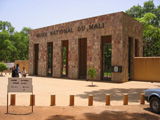
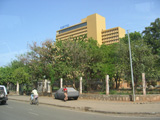

the blacksmiths' disctrict
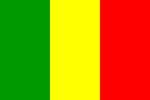 |
HEIR OF THE GREAT AFRICAN EMPIRES
A trip to Mali is an ethnical, historical
and architectural trip that from Bamako, "crocodiles' bank" reaches
the universe of Dogon people, crossing the site where the Bani and Niger rivers
meet and we find Mopti "the Venice of Mali", with Djenné "the
mud town", and at last Timbuktu' "the queen of the desert", about
which is said:
it is better to see with one's eyes rather that to be informed
by others...
For the ancient Romans, for the men
of Middle Ages and Renaissance, Africa evoked images of wealth and sumptuous kingdoms.
It was the cradle of wisdom and civilisation. In the vast region crossed by the
Niger river, in the period corresponding to our Middle Ages, different kingdoms
originated. These kingdoms were very developed civilisations under the social,
political and cultural point of view in regard to Islamism and Christianity. Many
of the territories that built up the so called sudanese kingdoms are today part
of the Republic of Mali. In this region the Niger river shapes a big bend that
enters the desert in the north. Thanks to its favourable position, this region
became the natural meeting place of all the trans-saharians trades that connected
the Black Africa with the Mediterranean Sea. The news of that historical time
tells us about caravans full of precious wares as ivory, amber, silk tissues and
glass works, spices and perfumes, but particularly gold and salt, and about the
legendary king of Mali Kankan Moussa, that left to Mekka with a thousand dromedaries
and so much gold to make collapse the Gold Market in Cairo for the following fifteen
years, and then also about the splendor of the courts, of rich libraries and coranic
universities. Big traditions, a great past, that can be breathed in the methaphisical
beauty of clay architectures, in the shady courts of the mosques, in the pages
of precious manuscripts, in the proud elegance of the peoples. For centuries the
Niger river was defined by the arab reporters "the Nile river of the far
West". Like the Nile it flows across the desert and was the witness of great
civilisations: on the banks prospered medieval kingdoms; river towns like Djenné,
Timbuktu' and Gao, rich of history and culture, they were called the
ports of the desert, apart from being for the river itself. Here the last caravans
of the salt met the slender boats of the fishermen and the big "pinasse"
of the the traders Songhai, Malinké, Bambara, loaded of wares and passengers.
In the river ports of Mopti and Segou, hundreds of pirogues travel
on the water, and hundreds more just rest at the pier. Coming and going of pirogues
and wares, people of land and people of river that give birth to a colourful carousel
of men dressed in blue djellaba or white burnus, women dressed with clothes in
brilliant colours and children of all ages, vendors of toasted seeds and sugar
fritters, sheep and zebus, baskets, carpets and bundles.
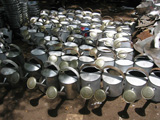
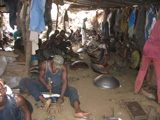
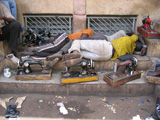
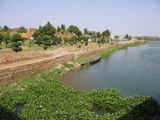
BAMAKO,
the capital
It is the capital
of Mali with a population of about 1,5 million inhabitants. It is a very active
town, with motorbikes and cars, people that buy and sell, and do business under
the hot sun of noon. In spite of all its problems, the town is very lively. Unfortunately
the Grand Marché (big market) in colonial style was destroyed by a fire
in 1933; sooner or later it ought to be rebuilt, but for the moment the stalls
are arranged along the sidewalks and the side roads where you can get lost very
easily because all roads seem to be the same. Here it is possible to find any
kind of ware: from indigo blue and golden materials to african music tapes. There
is also the typical vendor of traditional medicine. The National Museum
is one of the best ethnographic museums in west Africa and is sheltered in a building
inspired by old clay brick structures still nowadays visible in Djenné:
there is a rich collection of tapistries, masks, tissues, funeral furnishings
and weapons. The museum is trying to preserve with any means the artistic treasures
of the country, but the fight against the collectors of art that illegally buy
in Djenné, for a few cents, the old clay statuettes is foreshadowed quite
hard.
Bamako faces the west bank of Niger river. The central district, where
can be found the main markets, shops and restaurants, and also some hotels, are
situated in the triangle formed by Av. du Fleuve, Blvd. du Peuple and Av. van
Vollenhoven. The big Market (or better what remains of the market after a devastating
fire) is right in the middle of this triangle.
The town is very busy and has
nothing particular to offer apart the dirt and the poverty that is everywhere.
The very few hotels are: Hotel Salam, Sofitel, Mande and smaller hotels of lower
category.
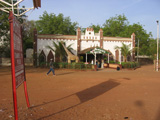
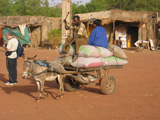
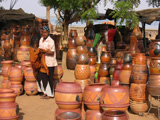
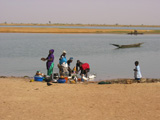
It
is the main town of Bambara, with 250 thousand inhabitants, and is located in
the nearby of Mbelba ruins, an ancient capital of this ethnic group. Ségou
with its boulevards of leafy trees, is a pleasant relief to the dusty and crowdy
streets in Bamako and has a more relaxed atmosphere: it keeps an evanescent fascination
of its glorious past and offers a nice picture of those days. If you visit it
on Monday, don't forget to visit the market place where, among the different wares,
can be found the materials woven by hand thanks which the region is famous. From
here it is possible to organize a full-day excursion to Niono, famous also as
the Venice of Mali due to its canal system and waterworks: its clay Mosque is
often immortalized in the pictures as the one in Djenné.
Ségou
is located 220 kilometers north-eTst from Bamako, along the Niger river, and can
be reached by boat or by bus. The collective taxis in service from Bamako to Ségou
are less frequent.

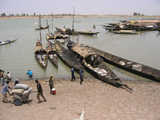
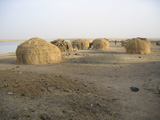
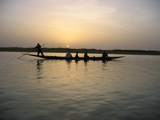
The
town has 130 thousand inhabitants and is located at the watersmeet of rivers Bani
and Niger. It is a commercial town 100 years old. In the middle of the XIXth century,
Al Hajj Umar made of what was a Bozo fishing place a military zone for his troops
at war in the Massina. King Ahmadou, the successor of the muslim conqueror wanted
that Mopte, which means "the reunion" in Fulani language, later called
Mopti, became the town of the peace and of the reunion of his people. From that
moment, the town held the role of melting-pot of civilisations, but became also
a commercial centre where the people that came from the south with their canoes
would have met camel-drivers from the desert. Consequently Mopti took the place
of the medieval role of Djenné as a commercial crossing, where was sold
salt and dry fish, cola nuts, millet and rice. The Bambara from Bamako and Ségou,
the Dogon people from the cliff of Bandiagara, the Soghai and Tuareg from Gao
and Timbuktu', in a few words, all the Malians met in Mopti. Around the port in
town can be heard speaking all the languages of the different ethnic groups. Every
day there is the market in Mopti, but the heyday is on Thursday, the market day
par excellence.
The main hotel of the town is the Kanaga**** located on the
banks of the Bani river. It is also worth to visit the Small Market with
fruit and vegetables, fish and meat, and on the second floor are located many
shops with any kind of souvenirs. It is also suggested to take a tour with
a pinasse along Bani and Niger rivers, perhaps stopping at a Bozo village
(fishermen) not far away.


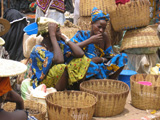
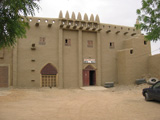
A town with
two faces, of clay and water. After the big autumn floodings, Djenné becomes
a town lagoon, reflected on the calm waters of the Bani river, tributary of Niger
river. As in Ganvié, the town built on piles in Benin, the pirogues full
of people and wares go until under the houses, whose pinnacles fronts inspire
in Djenné, during the sunset, that irreal aspect between land and water
of an exotic Venice. Djenné already existed when Rome had still to meet
Carthago. Fragments of pots, glass, pearls, jars and clay statues, warriors and
knights of different sizes have brought to light twenty three centuries of history
buried on a hill on the outskirts of the city, giving the chance to recontruct
the film backward of the most ancient urban reality of west Africa. Heart of the
great black sudanese empires and known on the great business route, Djenné
raises, in the old fourteenth century, a cathedral of clay, whose splendour celebrates
the opulence of a rich and active mercantile class. The commercial importance
of the town can be understood also in the elegant style of the private houses:
those of Djenné are houses of merchants that love to show off their welfare.
Along the alleys, in the small dusty squares, under the shadow of the portals,
terraces and façades, the today traveller can still read the traces of
a splendid, unknown African Renaissance.
The Mosque of Djenné,
favourite subject of photographers, completely built in clay and complete of overhanging
towers, stands out in the desert panorama of the region. It is the biggest clay
structure in the world, as well as one of the most refined examples of Sudanese
architecture. The only inconvenience is that it tends to melt with the rain and
it must always be readjusted at the end of the humid season.
Unfortunately
the non muslim visitors cannot get inside the mosque from when a fashion photographer
disturbed its quietness with a horde of models running everywhere inside it. Every
Monday, just outside the mosque, in Djenné takes place the biggest market
of all Sahel. A moltitude of traders belonging to all malian ethnic groups, invades
the square with beasts of burden that transport the goods, whereas the rafts continuosly
bring people and animals pushing the long poles in the shallow waters of the Bani
river. In an extraordinary totality of colors are piled up, on the ground or under
small tents, edible tubers and vegetables, aphrodisiac as the cola nuts, salt
slabs from Sahara mines, fresh and smoked fish, millet, rice and hot pepper, karkadé
and black pepper. Everything can be found in this market: silver, gold and amber
necklaces for the rich Bambara and Soniké women, concoctions of the traditional
pharmacopoeia, dyed and embroidered leather shoes, bags and saddlebags of caravaneers,
perfumes and ointments, materials and vegetable dyes, imported plastic or porcelain
tableware, striped blankets from Timbuktu', old sacred arab books, baskets full
of golden mangoes or papaias, overflowing peanut basins that wait along a road
or at the entrance of the villages. All Africa is a land of markets, and the market
is above all woman: women with their sleeping children tied up on the hips or
sleeping among the baskets, women that travelled on foot tens of kilometers of
track bringing on the head, with the confidence and elegance of queens, chickens,
fruit and vegetables.
Djenné is about 400 kilometers from Bamako, and
can be reached by bus or by "pinasse" (big motor canoes).
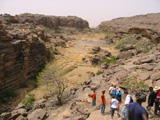
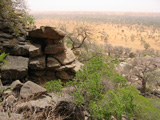
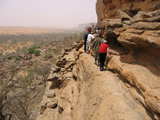
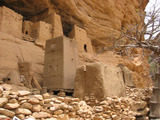
The main attraction
of a trip to Mali is probably a trekking in the Dogon region, going along the
Bandiagara Cliff. The Dogon people has a complex and varied culture, and it is
famous for its masterpieces: an itinerary on foot is therefore the ideal solution
to observe from near the pink sandstone houses and the barns excavated in the
rock walls, and to learn something about gardening in the smallest spaces. As
a matter of fact, the Dogon cultivate tiny plots of land along the edges of the
rocky walls. If you visit Mali during the month of April it is possible to attend
the Fête des Masques (masks feast), with dances and millet beer. The other
important festival of the Dogon society is the market day, which falls every five
days: it is a moment of big excitement for the village, which reaches the climax
around noon and is usually animated with jokes and gossip, and by the ubiquitous
millet beer.
The Bandiagara Cliff is 135 kilometres long, and spreads out from
Douentza to the north, and to the outskirts of Bankas to the south. Bandiagara,
Bankas and Sangha are all very popular departure localities for trekking: Bandiagara
and Bankas are 550 kilometres from Bamako, whereas Sangha is located 40 kilometres
to the north. These villages can be reached by plane, by bus or by boat from Bamako
till Mopti, and by a small bus or collective taxis from Mopti forward. The trekking
from Sangha to the dogon village lasts two and half hours, with overhanging rocks,
hardly walkable by whom suffer from vertigo. It is suggestable to have climbing
boots and at least a bottle of water. Nevertheless, tourists are always accompanied
by local boys that are available to help during the descent down the escarpments.
Of course a tip is always well accepted as thank-you.
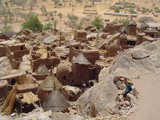


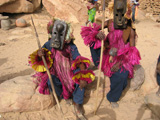
…I will show you the sacred places, inaccessible and untouched, I will disclose the secrets of a universe where everything is magic and untouchable...
The
world discovered the existence of the Dogon people just seventy years ago, when
the ethnologist Marcel Griaule went to study their habits thinking of a primitive
ethnic group. But, on the contrary, he realized that this people having taken
refuge on the isolation of an inaccesible cliff, knew from thousand of years the
secrets of the blood circulation, which was studied by the western medicine in
1600. He also discovered that the Dogon knew the orbit of Sirio B, an invisible
star with the naked eye, much earlier than astronomers, and they had precise knowledge
about Jupiter and about the ring of Saturn, they knew that the moon was sterile
and that the sun burns away. And it is right Sirio B, that they called Po-tolo,
the star of the origins, the one they abandonned in the antiquity aboard of an
ark to reach the Earth alighting with great wind and noise. The world, according
to the Hogon, the great priests that speak a mysterious and secret language, renews
every 50 years, when Po-tolo crosses the Bandiagara valley. The astronomers established
that the orbital revolution of Sirio B lasts, as a matter of fact, 49 years and
98 days, and to celebrate the reappearance of Sirio B, the Dogon celebrate each
50 years the Great Feast of Sigi. The dogon villages are located on the cliff,
and are considered a masterpiece of architecture, perfectly integrated with the
environment. The art of Dogon people is as original as their culture and is one
of the most interesting and beautiful documents of the african art. The dogon
art penetrates every aspect of the daily life: the images of the mythical ancestors
are not only represented in the cult places, but can be met on the pillars that
hold up the togu na, on the door-knockers, on the door-locks, on the drums and
on the profane objects used for the work on the fields. Schematic human faces,
mythical animals like the antelope, the fox, the crocodile, are the fascinating
references of an archaic mythology contained in the rock's heart of a cliff to
outlive to the various events of the history. The discovery of the Dogon people
through the work "God of water" by Marcel Griaule (1933) and the scientific
publications that followed at a brisk pace have brought to the knowledge of the
world a precious fragment of african wisdom: for the first time an african people
got out of the "primitive" disorder and from the reign of the instinct
into which the western culture relegated the black culture. But this "celebrity"
demanded a tribute: the Dogon people have become a privileged target of masterpieces'
thieves and have seen disappeared memories of their culture in the tricks of the
world.
The Dogon's values system is based on a fascinating and complex cosmogony
where the word plays a key role: the word has a vital force, that is given and
received. Every aspect of the daily life has for this people a ritual value: thus
the movements of the weaver on the loom symbolically repeat the movement of the
universe, the peasant throws the millet seed on the thirsty fields designing a
spiral, the same one that the universe made to expand. To the land, that they
consider as a mother, they dedicate extraordinary attentions, and the settlement
of each village is not by chance, but corresponds to a precise sacred topography.
For this reason, the visitor that travels on the Dogon's land must be previously
instructed not to step on the sacred places of which is dotted "the great
rock". It is necessary to know that every element, apparently meaningless,
like a tree, a stone, an animal or a handmade object, preserves a spirit. Even
here, in the original universe of the cliff, the history that the Dogon people
could keep far away for a millennium avoiding the islamicization imposed by the
Almoravids and resisting to the raids of the valley knights, is besieging them.
The larger facility of contacts and interchange, produce day by day overtures
and behaviours that are no more compatible with the tradition and the fragile
universe of the cliff.
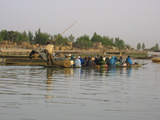

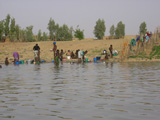

The river tells the life
…silence, daily efforts, on the land where nothing is by chance -
archaic gestures repeated to infinity...
Communication
lines between the peoples of black Africa and the saharian Countries, cradle of
ancient civilisations, the Niger river reserves still nowadays the charm of the
big rivers. Along its flow die the caravan tracks of once upon a time, river landscapes
alternate with sand dunes, clay towns with groups of huts and villages, the colourful
crowds of the ports and the long pirogues leave the space to the slender fishermen's
boats that swing between sky and land. The malian people call it "Djolibà",
that in malinké language means " the big blood". Arterial road
of vital importance in the life and economy of Sahel's peoples, the Niger river
rises from Guinea, in the massif of Fouta Djalon, crosses Mali for about two thousand
kilometres forming a huge internal delta, laps the desert in the northest point
of its flow designing a great bend between Timbuktu' and Gao, ethnic and cultural
limits between the two worlds, and then flowing anew to the south and reaching
the Atlantic Ocean in the Gulf of Guinea crossing the Republic of Niger and Nigeria

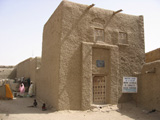
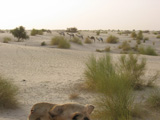
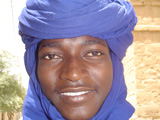
Town
of the sciences, of flourishing coranic universities, of wise and venerated Marabouts,
born at the crossing of the big caravan tracks that connected the Mediterranean
Sea with the Black Africa across the huge desert areas of Sahara, Timbuktu' reached
its highest splendour in the XVIth century with a population of hundred thousand
inhabitants (nowadays only 35 thousand), a cross-section of different ethnic groups
of the Sudanese empires of that time: Berbers, Arabs, Moors, Haussas, Fulans,
Songhais, Bambaras, Tuaregs, that settled building each of them one's own district,
attracted by the profitable commercial perpectives and by the reputation of the
intellectual environment. The islamic university of Timbuktu' became so famous
that from Egypt, from Persia, from Spain and from all the Maghreb poured in men
of letters, theologians and professors. Under the clay colonnades of its mosques
studied and discoursed twenty thousand young men, hundreds of scribes compiled
in Arabic the volumes of a huge library that left very old illuminated Qurans,
treatises of physics, theology and astronomy. The library of the muslim marabout
Ahmed Baba, preserves 12 thousand precious manuscripts, and represents the memory
of the town. Timbuktu' appeared for the first time on a map of the XIVth century.
The cartographer called it Tembuch. The Tuaregs that three hundred years
before had founded a settlement at the borders of Sahara desert had entrusted
the daily life with a woman whose name was Bouctu. From then Timbuktu'
(Tombouktou for the French speakers), the well of Bouktu, has driven the men crazy.
Legend town, myth town of every traveller, border town, mystery town , "queen
of the desert". Fifty two days of travel by dromedaries from Zagora, in Morocco;
fifteen days of caravan from the salt mines of Taudéni, three days of navigation
from Mopti: Timbuktu' really exists. Town of sand and dust, town crumbled and
dilapidated. Bruse Chatwin, years ago, scornfully said of it: "It is not
nice at all". He is right. He is completely wrong. The Tuaregs explain: "The
Word of God, the small stories, the happy tales, the wise things can be found
only in Timbuktu'". A town where women show only one eye because no man in
the world could "support their look without getting crazy". A town without
walls because "its beauty, by itself, would stop every enemy". Timbuktu'
is also the five hundred pillars that hold up the vaults of Djinguere-ber mosque,
built in 1325.
Plates built into the clay walls remind the houses where the
first white men lived in Timbuktu': the english major Gordon Laing, who was killed
by his men and could not narrate his venture; the french explorer René
Caillé that arrived disguised as an Arab; the german geographer Henrich
Barth that needed five years to cross the desert. And we don't have to forget
that Donald Duck, in order to run away from Uncle Scrooge, was always hiding himself
in Timbuktu', unachievable place.
The best way to reach Timbuktu' is sailing
along the river, either with passenger boat or with a pinasse. If the level of
the river is too low and does not allow the passage of the boats, you can use
an off-roader. The distance between Mopti and Timbuktu' is about 420 kilometres.
From Mopti to Douentza the road is asphalted; then starts a dirt road 200 kilometres
long that takes to the river, which can be crossed by ferry; then starts the road
lined of eucalyptus trees, 15 kilometres long, to the the mythical Timbuktu'.
During the journey no trafic, hotels or restaurants are met. It is important to
bring with water and a good driver that is also mechanic in case the car stops.
The desert is only with bushes and nothing more. Here and there, sometimes, some
huts and goats...
The most used word around: Tubàbu (white man). The children are
the first that call the turists using this word,
and asking for a cadeau
(present).
Exchange rate of 06th of April 2005:
1 € = 655,21 F.CFA
(franks of the Communauté Financière Africaine)
African Financial Community
1 USD = 509,18 CFA
To every
transaction 2% commission is applied.
